MarketMuse vs Frase
This post is a detailed comparison of MarketMuse vs Frase regarding content strategy and planning, content research, optimization, natural language generation, and content briefs. Since this is a very long post, I’ve summarized it as follows.
Frase essentially crawls the top 20 results, uses basic term frequency technology to extract related words and entities, and sorts them. This is a recipe for copycat content – you basically get an outline on how to write the same article everyone else wrote.
Using our patented technology, MarketMuse takes a topic (not just a long tail keyword) and analyzes tens of thousands of pages related to that topic, completely independent of what the top-ranking pages are. MarketMuse creates sophisticated topic models by understanding related topics and following links until we build sets of millions of content items.
The difference between the two approaches is that Frase’s approach assumes that what the top 20 ranking pages have written constitutes a “guide” to writing authoritatively about a topic. They are assuming a correlation between Frase’s list of related topics and ranking well.
MarketMuse uses natural language technology and AI to analyze a much larger data set than 20 pages. This gives you a much more high-fidelity model of what it means to be an expert on a topic. Only when we’ve constructed our topic model do we compare the top 20 ranking pages to it.
MarketMuse reveals how your competitors stack up to the model, not how you can use them as a model.
Let’s get started!
Content Strategy and Planning
With hundreds, or even thousands, of pages and topics from which to choose, how do you prioritize? This is where machine learning and artificial intelligence can be of immense value to content teams of all sizes.
Content Strategy and Planning With MarketMuse
MarketMuse is a content intelligence platform with a deep understanding of your content, its associated topics, and the content of your competitors. With the help of personalized content metrics, you can create AI-driven content plans with high confidence that they will succeed. This is possible because MarketMuse maintains a continuous inventory of your site.
Give MarketMuse a topic, and it can determine how well it will perform, should you decide to write content on that subject. It does this by assessing how well you’ve covered the topic in the past, how it has performed, how the competition has fared, and other factors. It uses this to create personalized authority and difficulty scores.
MarketMuse is the first to offer a Personalized Difficulty score ever in the industry.
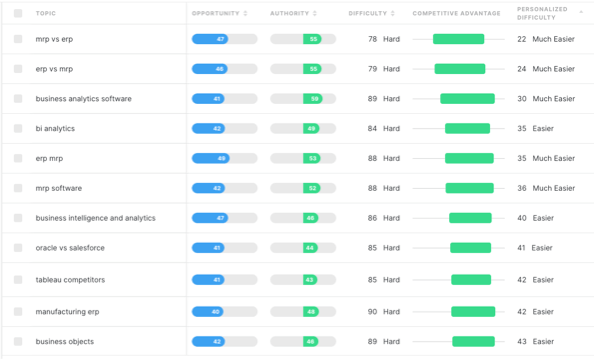
MarketMuse provides content teams with essential decision-making metrics to help prioritize which of pages and/or topics you should be worked on for the biggest impact.
Unrealized value
Your unrealized value is based on an estimation of traffic and its value (CPC x traffic as a default, but customizable). This allows you to quickly identify high-value opportunities.
Personalized difficulty
The personalized difficulty metric is a custom score based on the topical authority of the content you’ve already published. The higher your authority, the lower your difficulty, and vice versa. This score helps you determine which opportunities are the easiest to execute.
Competitive advantage
Your competitive advantage is how likely content you post on a specific topic is likely to succeed. This metric shows you the difference between difficulty (which applies to everyone) and personalized difficulty (which is specific to your site).
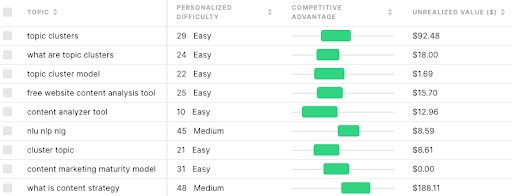
As you make decisions about what new content to create and pages to update, these can be assigned to content plans within MarketMuse. Plans are useful for keeping work organized, tracking what tasks have been done, and creating briefs.
Content Strategy and Planning With Frase
Frase offers content analytics which give you insight into ranked pages, clicks, and traffic growth. The dashboard identifies which pages are performing and which need work, categorizing pages into buckets like “quick wins,” “decay,” and “top result,” and “opportunity.”

Where Frase falls behind the curve here is in Personalized Difficulty metrics and opportunity scores that give you a real prediction of the impact of those “quick wins” and “opportunities.”
Bottom line
MarketMuse
- AI-driven content plan to identify opportunities for optimization and new content
- Personalized Difficulty scores to determine how topics will perform
- Opportunity score to help you prioritize your work for the biggest impact
Frase
- Content performance analytics
- Identify optimization opportunities
Content Research
The volume of content published now makes it impossible to research what is truly needed to write a high-quality article. Thoroughly understanding the buyer’s needs, search intent, competitive content, and your own content performance requires the help of AI.
Content Research in MarketMuse
MarketMuse extracts massive amounts of data from the web. We pull content from thousands of pages, using natural language processing to determine not only who covers this topic at an expert level, but exactly what you need to do better.
Going the extra mile ensures high-fidelity data resulting in high-quality recommendations. Our topic model suggests 50 related topics to cover for any given subject.
Plus, our Compete Application enables you to quickly research competitive content to understand how well they cover a subject, including their Content Score, word count, and content gaps.
Content Research With Frase
Frase extracts its information from a limited set of documents, the top 20 for a specific search term. Using such a limited collection of documents severely impacts the fidelity of the topic model. Read this post on why you need to look beyond the first couple of pages in Google.
Bottom line
MarketMuse Research
- Processes thousands of pages for expert comprehension of a topic
- Competitive analysis with score, word count and gap analysis
Frase Research
- Processes top 20 ranking pages
Competitive Content Quality Analysis
Use this to determine the weakspots in your competitors, or your own, content. Take that insight and use it to differentiate your content.
Competitive Content Quality Analysis With MarketMuse

You can perform a competitive content quality analysis of the SERP or any website. For larger sites, you can exclude or include various parts — great for getting real granular.

Competitive Content Quality Analysis With Frase
Frase offers a similar experience but it’s limited to the SERP only. So you can’t investigate a competitor’s website to get insight into their coverage or their content strategy.
Bottom line
MarketMuse Competitive Content Analysis
- Available for both SERP and any website
- Get insight into your competitors’ coverage and content strategy
Frase Research
- Limited to the SERP
Content Optimization
The best content is created with the highest quality data-driven insights. Let’s see how both experiences compare.
Content Optimization With MarketMuse
The MarketMuse topic model is very robust. As a result, the Optimize application shows 50 related topics for a given subject (focus topic).
Content Score
MarketMuse Content Score accounts for the proper usage of related topics in competitive pieces across the web. In Optimize your Content Score is updated live, based on your coverage of relevant topics, as you write. It shows how your content stacks up against the competition.

Every mention of a topic in the related topic list earns a point, with a maximum of two points for each item. Since there are 50 related topics in the list for any given topic, the theoretical maximum is 100.
The Average and Target Content Score section breaks down significant ranges of Content Scores. The Average number shows how comprehensively articles ranking for this term are commonly written. The Target score shows the coverage you want to meet or exceed.
The current Content Score visualization graph displays your progress toward a target content score, showing if your content currently has below average (red), average (yellow), or target coverage (green).
Word Count
MarketMuse also tracks your word count and shows how it stacks up against the rest of the content performing well for your query. This is the word count of the content you are working in the writing area and changes as you write.

Average and Target Word Counts are derived from extracting content across expert pieces that cover this same topic.
The word count bar shows how close you are to fulfilling the target word count. It will fill up as you write, being filled all the way means the target was hit or exceeded.
Related Topics Table
This table shows the essential topics to include in your article and approximately how often they should be mentioned. The core related topics are ordered by relevance to the focus topic.

Distribution, abbreviated to DIST, shows a range of how often you mention this topic in your piece. Suggested Distribution shows MarketMuse’s recommendation concerning the number of times you may want to mention this topic. Clicking on a related topic in this list reveals a slide-out with variants of that topic you can use to enrich your writing.
Using Frase to Optimize Content
Frase has a wonderful text editor that also incorporates images into the articles. Beyond that you’ll find significant concerns about their topic modeling. Let’s use our post on content strategy as an example.
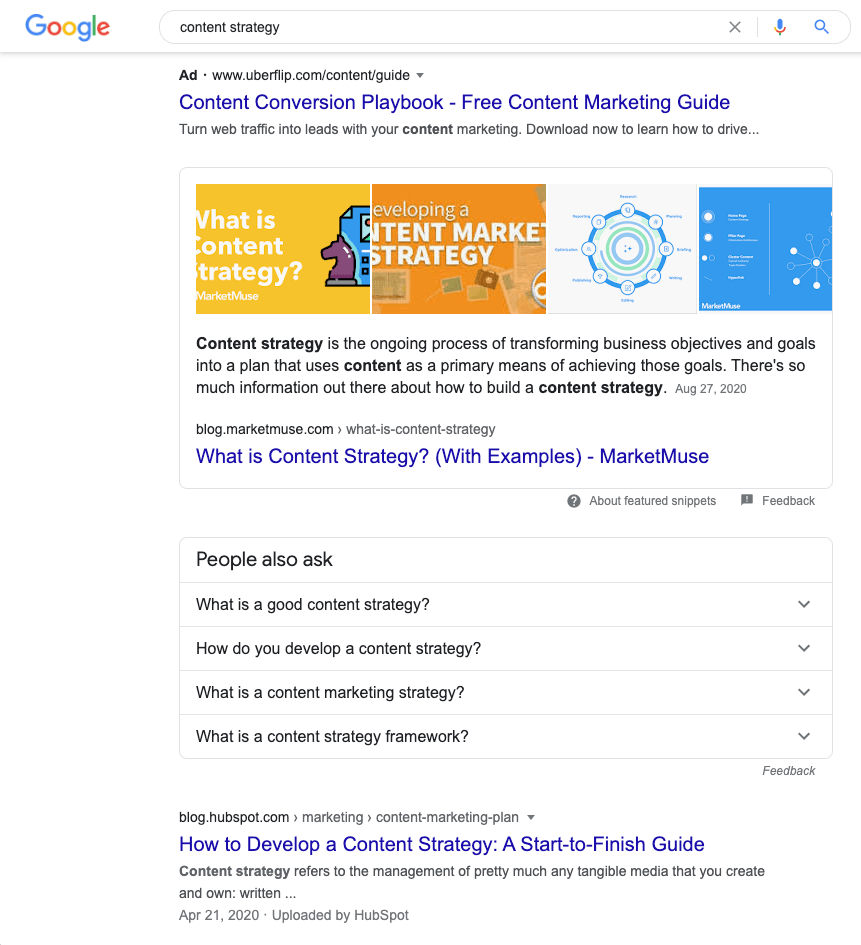
This article is doing quite well. But is it perfect? That depends.

Frase can lull you into complacency by claiming this to be a perfect post. It insists we scored 100%! But nothing is ever perfect. In fact, according to their topic model, we missed a lot of topics such as:
- Stick
- Hopes
- Surprise
- Rachel
- Internet
- Minute
- Blanks
- Chance
- Percentage
- Heart
- Location
- Oxford
- Substance
- Chris
- Clutter
- And many others
Frase lists 200+ related topics for the subject of this post. So, if you’re a fan of lots of data you’ll be happy. But if it’s quality data you’re after, that’s another story.
In data science there’s a concept known as n-grams; think of it as the number of words used to describe a topic. Complicated topics typically require more words to describe a concept.
So you have topics made up of:
- Unigrams (one word)
- Bigrams (two words)
- Trigrams (three words)
- Four-grams (four words)
The topic model Frase created for the subject “content strategy” contains an unusually high number of unigrams. Here’s the breakdown:
| n-gram topics | Frase | MarketMuse |
| Unigram (1 word) | 56% | 8% |
| Bigram (2 words) | 33% | 74% |
| Trigram (3 words) | 11% | 14% |
| Four-gram (4 words) | 0% | 4% |
Incorporating unigrams into a topic model isn’t wrong per-se. MarketMuse’s topic model for the same subject (content strategy) has these four unigrams; marketing, strategy, marketer, SEO.
But there are two major issues with Frase’s topic modeling:
- It doesn’t offer sophisticated suggestions, as seen by the lack of higher-order n-grams in its topic model.
- Many of the single-word topic suggestions are irrelevant (see the above list).
This lack of data fidelity is a major concern.
Optimizing for the wrong things faster doesn’t make it better.
Bottom line
MarketMuse optimization
- Robust, high fidelity topic model with highly relevant topics and suggested distribution
- Content score goal and competitive analysis
Frase optimization
- Provides plethora of data in topic suggestions, but results seem unrefined
Generative AI
Generative AI assists writers and content marketers in generating ideas, crafting compelling narratives, and even automating the content creation process. With it, writers can overcome creative blocks, enhance productivity, and explore new avenues of storytelling. By harnessing the potential of generative AI, writers and content marketers can unlock a world of endless possibilities, enabling them to create captivating and impactful content like never before.
Bottom line
Both companies offer wonderful solutions. But with Frase, you’re going to have to pay extra.
Content Briefs
The purpose of a content brief is to give writers detailed and structured guidelines so they can create better content, faster and with less editing.
MarketMuse Content Brief
A MarketMuse Content Brief consists of three sections; the executive summary, outline brief and Optimize. There are two types of content briefs; one for creating new content and another for updating an existing page. Both are very similar, but briefs for existing pages take into account the content that already occurs on the page.
Every MarketMuse Content Brief uses a sophisticated topic model consisting of one model for the main subject plus one model for each subheading.
Anyone can access a specific MarketMuse Content Brief through a shared link.

Let’s examine each section to understand their purpose and function better.
Executive Summary
As its name implies, the executive summary provides a marketing executive with the background necessary for why this content should be created and how it will be done. The summary opens with information about the target score, potential increased monthly views, and suggested word count, along with a description of what these indicators mean.
Determine ideal user Intent and audiences.
This section explains who the audience is and why they are searching for this topic.

Discover questions to answer when you’re writing.
This section looks at some relevant questions surrounding this topic so you can make sure your content is focused on what’s important to your audience.

Choose your article title.
Here we see several titles that are ranking for the topic plus suggested terms to include in your title to set yourself apart.
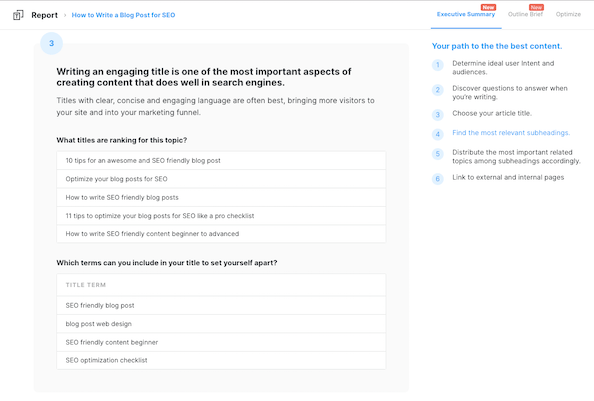
Find the most relevant subheadings.
Similar to the previous sections, you see subheadings that rank for this topic plus some terms that you should include to differentiate your post from the competition.

Terms that can guide your content toward topical authority.
A list of all the relevant subtopics related to the subject. The size of this varies with the number of subheadings and target word count.

Link to external and internal pages
Suggested links and anchor text for the most appropriate internal web pages. Same thing for external links, but these are to non-competitive sites.

Outline Brief
Information in the Outline Brief is designed to help writers create better content faster. This includes an article structure complete with subheadings so that writers spend less time on research and get more done.
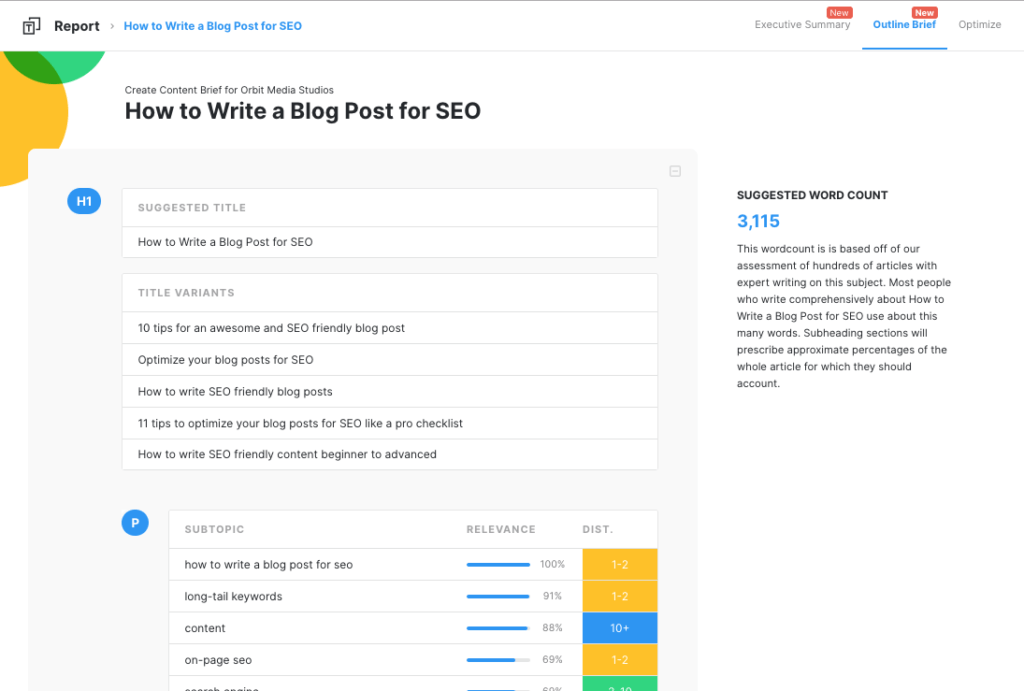
Suggested Word Count
On the right side of the brief is a suggested word count based on the average and taking into account the target word score. Each section also has a recommended word count displayed as a percentage of the total word count. This gives writers an idea of how much space to devote to a subsection without getting side-tracked in meeting a specific word count target.
Suggested Title and Title Variants
One suggestion is provided along with several variants should the writer wish to refine the title further.
Subtopics
This is a list of subtopics to mention, some of which can be included in the article’s introduction. ‘Suggested Dist.’ refers to the number of times to mention a topic without it appearing awkward and unnatural.
Subheading
A MarketMuse Content Brief typically contains several subheadings. Each one follows the same format:
- Suggested subheading
- Suggested word count for that section (expressed as a percentage of the total word count)
- Questions to answer
- Topics to mention including their suggested distribution
- Internal linking strategy where the anchor text is a highly relevant topic while the suggested link is a page that’s a good match for that topic
- External linking strategy where the anchor text is a topic with lower relevance with a suggested link of high authority and quality
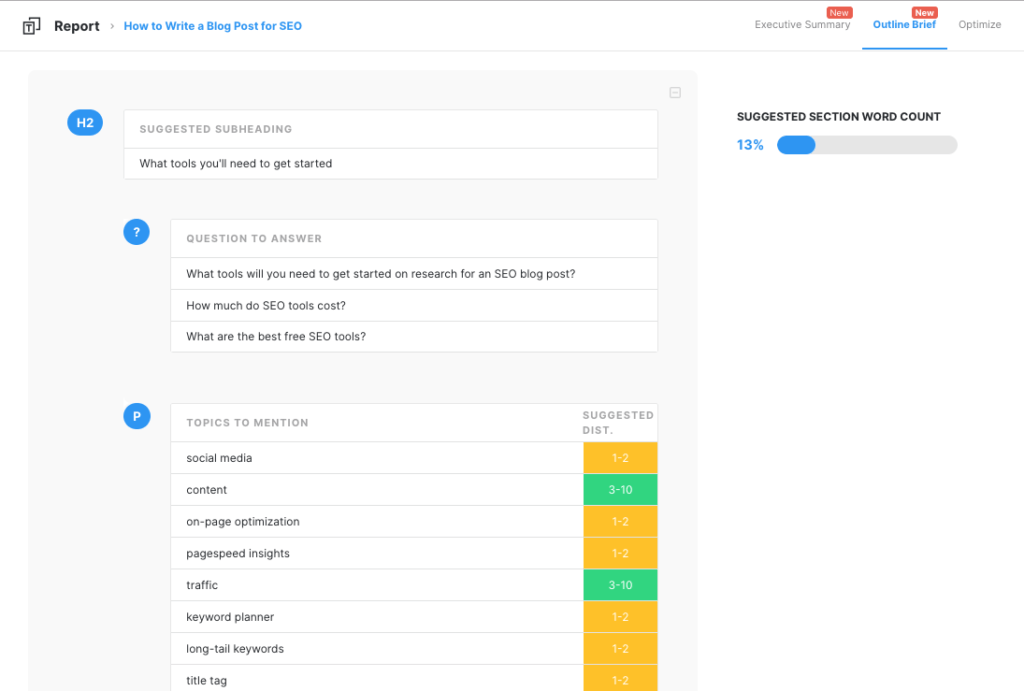
Note that each section has its own set of related topics. While there is some overlap between the sections and the main topic, the resulting list is typically two-and-a-half times more extensive than what’s found in a Frase content brief.
External links are chosen based on anchor text with low topical relevance for a special reason. We want to link to a high-quality, authoritative source that’s not in direct competition with the topic our article targets. This is achieved by choosing topics that are adjacent to the central theme, thus providing value to both the audience and search engines while helping to achieve the goals of the article as well.

Optimize
The third tab in this shareable MarketMuse Content Brief is Optimize. It works just like the Optimize app, except it’s prepopulated with topics from the brief. Writers can use this in two ways:
- Craft the article directly in Optimize (content score and word count automatically updates as you write)
- Create a post using your favorite word processor and then check it with Optimize prior to submission

Frase Content Brief
Although they call it a content brief, that’s not what Frase offers. Rather they offer data that one could use to create a content brief, which is distinctly different. With no structure and very little guidance, writers need to be well-versed in SEO in order to avoid making common mistakes, like linking out to the competition.
We’ll analyze each section as they appear in this example brief.
Overview
The overview provides some very basic information like average word count, the average number of headings, the average number of links, and the average number of images. That’s an observation, but it does not provide a writer with direction.

Sources
The origin of these sources is not clear. There are 17 sources presented here, but given that Frase only searches the top 20 in Google, we can assume they come from the first two pages in the SERP.
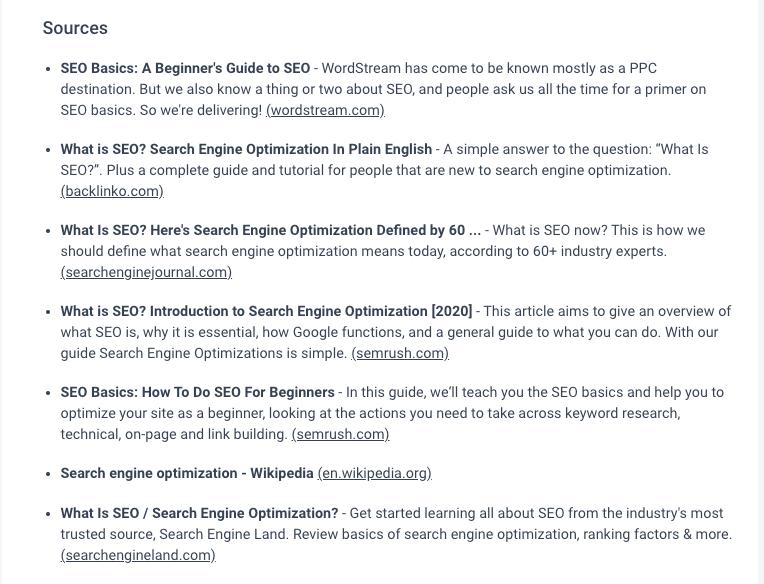
This section should really be called SERP Competition because the entries in this list appear in the SERP for the search term being targeted. Labelling it “Sources” will most likely result in a writer quoting from these pages and linking to them, SEO MISTAKE 101.
Top 20 Topics
This is a limited list of 20 topics based on a limited analysis of the top 20 documents. Using such a small corpus results in data quality and fidelity issues, with a topic list that doesn’t tell the full story.
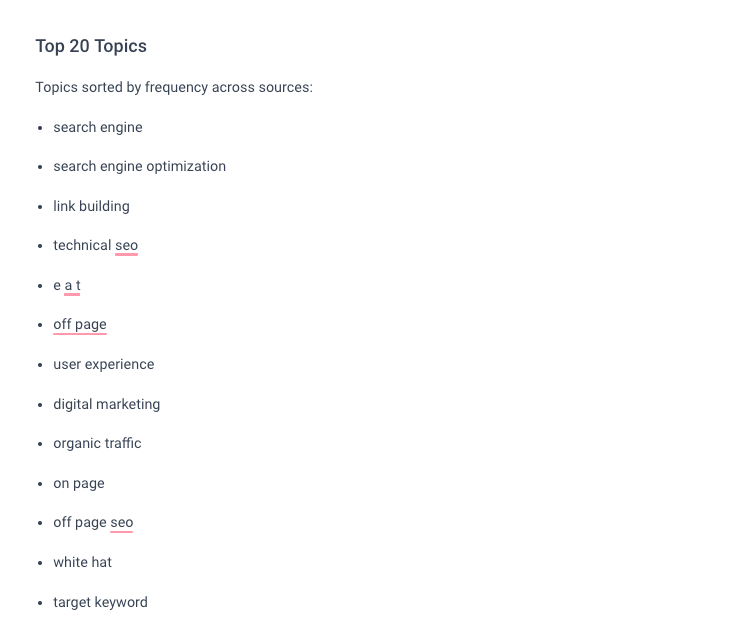
Headers
This is a list of headers found in the ranking sources. These can provide ideas on how to structure your subheadings. But there’s no direction on what to do with this information.

Questions
Questions being asked on the internet that are related to your document.
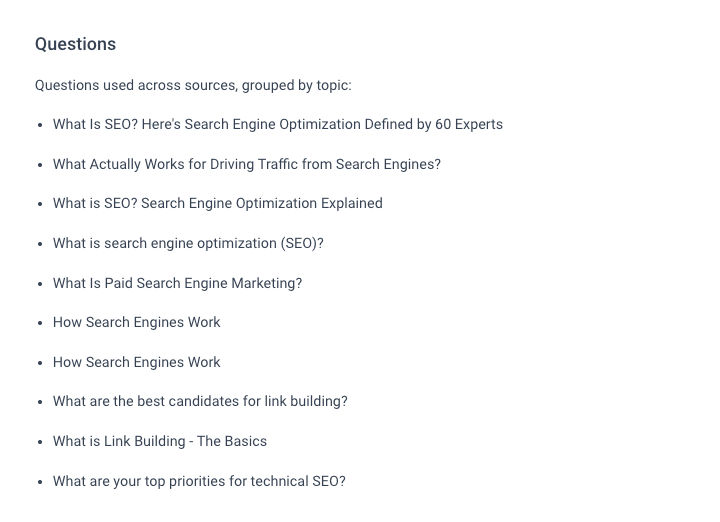
Statistics
These statistics are factoids Frase finds within its sources. It’s a great idea but dangerously executed. The problem is that the sources for these statistics are your top 20 competitors in the SERP for the search term for which you’re trying to rank. From an SEO perspective, it’s bad practice to link out to these pages.
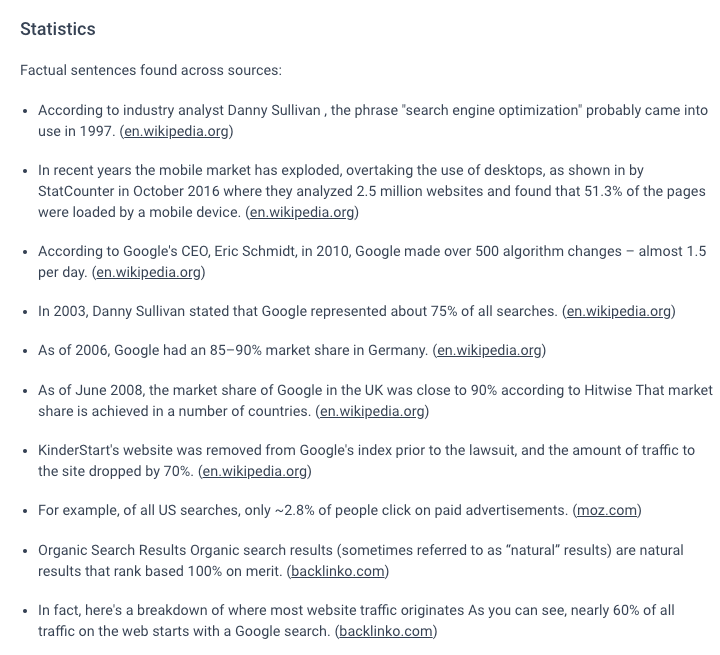
The way this is structured, writers will most likely copy these statistics and link out to the source mentioned. There are two problems with that:
- You’re linking out to your direct competition, which is never good.
- The statistics mentioned aren’t necessarily from the original source. Not linking to the original source is sloppy journalism.
Links
This section provides a list of links found in its sources. Unfortunately, some of these links are to competitors that appear in the top 20 of the SERP for the search term you are targeting.

Once again, the risk is that your writer uses these references to link out to SERP competitors using highly relevant anchor text. This is still a big mistake!
Bottom line
MarketMuse Content Briefs
- Provides average and suggested word count, headings and links
- Questions to answer
- Topic analysis includes thousands of relevant pages
- Title, header and subheading suggestions
- Suggests internal and external links to related, but non-competitive domains
Frase Briefs
- Provides average word count, number of headings, and number of links
- Questions to answer
- Topic analysis limited to top 20 ranking pages
- Ranking headers don’t include suggestions for differentiation
- Suggested links include competitor pages
The Takeaway
Frase has a limited number of workflows and suffers from data quality and fidelity issues. Their content briefs are deficient across several areas and fail to improve the content creation process substantially.
MarketMuse offers many workflows designed especially for content strategists and their teams. AI-driven content plans, highly structured and details content briefs, plus MarketMuse NLG Technology (natural language generation), means content teams can do more, better, and faster.

Jessica was a Content Marketing Manager at MarketMuse, collaborating with marketing team, product, customers, and industry experts to scope and produce compelling media and impactful content strategy. Connect with her on LinkedIn.